Healthcare: Personal and Professional Development Report Analysis
VerifiedAdded on 2019/12/03
|16
|4772
|159
Report
AI Summary
This report provides a comprehensive analysis of personal and professional development within the healthcare sector. It begins by exploring the personal values and principles of healthcare practitioners and how these interact with service user principles, cultural influences, and the impact of new developments and changes. The report then delves into a SWOT analysis to identify strengths, weaknesses, opportunities, and threats, followed by the creation of a personal development plan with short and medium-term goals, resources, and monitoring strategies. It also examines the importance of professional boundaries, promoting service user rights, and managing conflicts. The report concludes by discussing the limits of care roles, the impact of personal contributions, and strategies to enhance teamwork in healthcare settings, offering practical ideas for improvement.
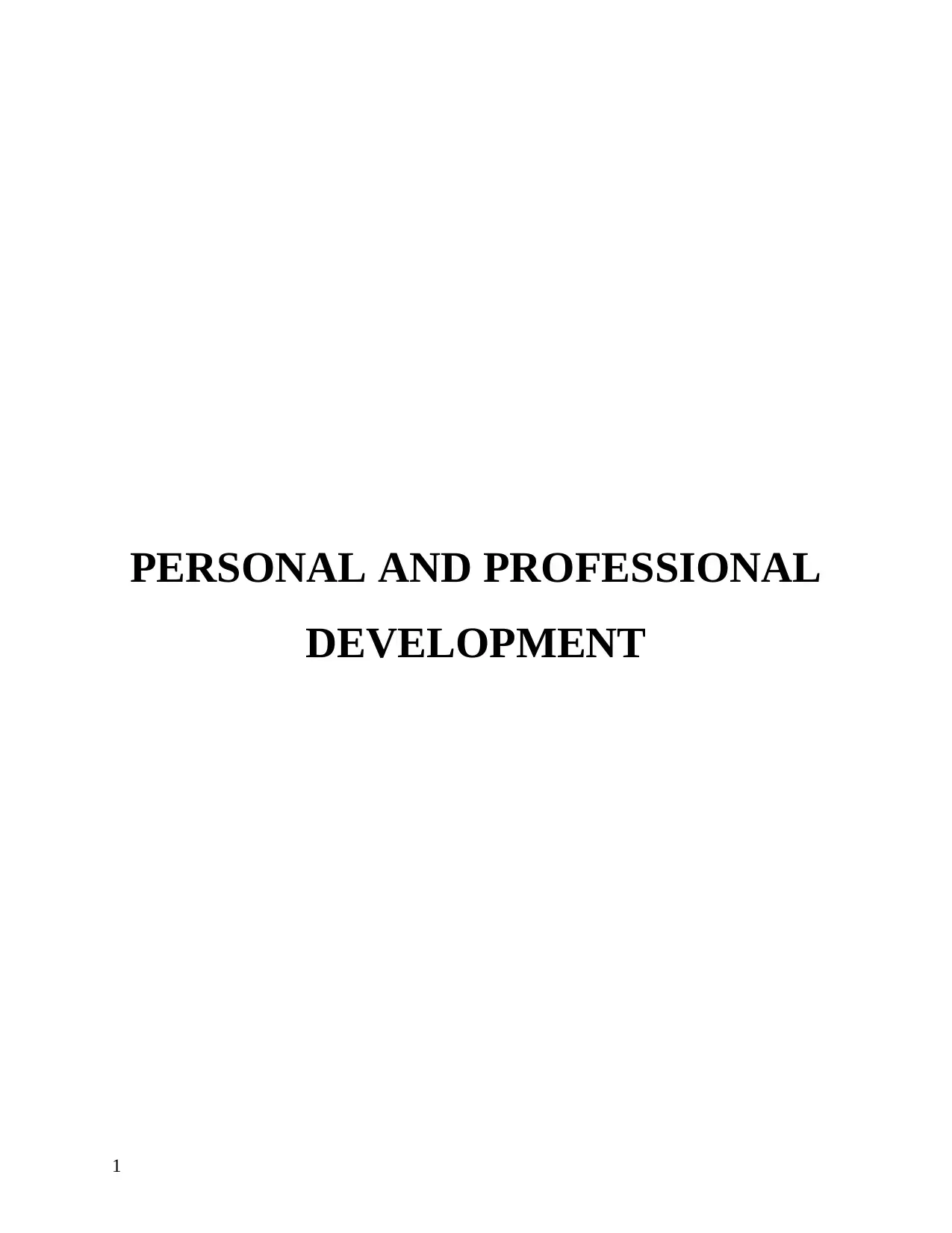
PERSONAL AND PROFESSIONAL
DEVELOPMENT
1
DEVELOPMENT
1
Paraphrase This Document
Need a fresh take? Get an instant paraphrase of this document with our AI Paraphraser
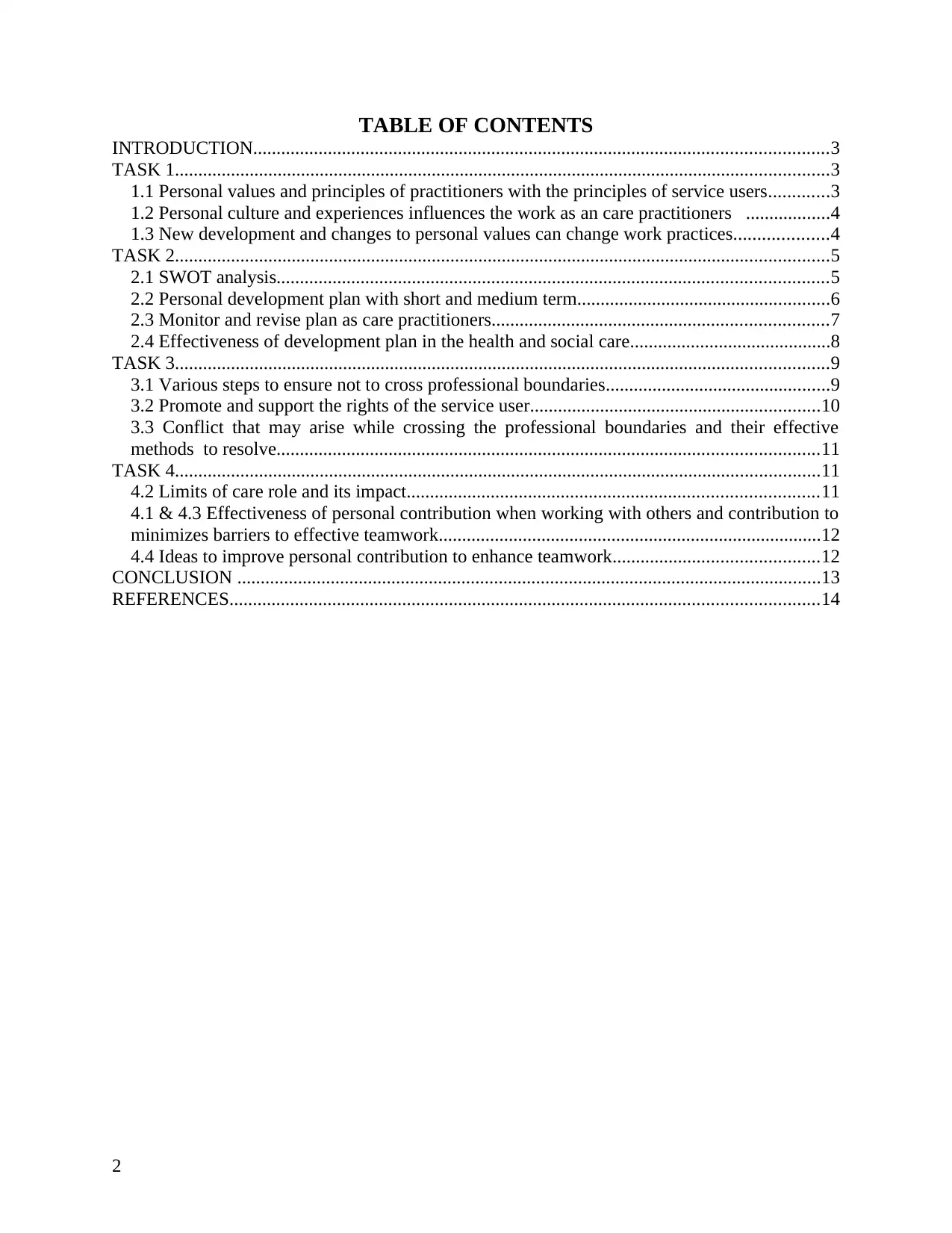
TABLE OF CONTENTS
INTRODUCTION...........................................................................................................................3
TASK 1............................................................................................................................................3
1.1 Personal values and principles of practitioners with the principles of service users.............3
1.2 Personal culture and experiences influences the work as an care practitioners ..................4
1.3 New development and changes to personal values can change work practices....................4
TASK 2............................................................................................................................................5
2.1 SWOT analysis......................................................................................................................5
2.2 Personal development plan with short and medium term......................................................6
2.3 Monitor and revise plan as care practitioners........................................................................7
2.4 Effectiveness of development plan in the health and social care...........................................8
TASK 3............................................................................................................................................9
3.1 Various steps to ensure not to cross professional boundaries................................................9
3.2 Promote and support the rights of the service user..............................................................10
3.3 Conflict that may arise while crossing the professional boundaries and their effective
methods to resolve....................................................................................................................11
TASK 4..........................................................................................................................................11
4.2 Limits of care role and its impact........................................................................................11
4.1 & 4.3 Effectiveness of personal contribution when working with others and contribution to
minimizes barriers to effective teamwork..................................................................................12
4.4 Ideas to improve personal contribution to enhance teamwork............................................12
CONCLUSION .............................................................................................................................13
REFERENCES..............................................................................................................................14
2
INTRODUCTION...........................................................................................................................3
TASK 1............................................................................................................................................3
1.1 Personal values and principles of practitioners with the principles of service users.............3
1.2 Personal culture and experiences influences the work as an care practitioners ..................4
1.3 New development and changes to personal values can change work practices....................4
TASK 2............................................................................................................................................5
2.1 SWOT analysis......................................................................................................................5
2.2 Personal development plan with short and medium term......................................................6
2.3 Monitor and revise plan as care practitioners........................................................................7
2.4 Effectiveness of development plan in the health and social care...........................................8
TASK 3............................................................................................................................................9
3.1 Various steps to ensure not to cross professional boundaries................................................9
3.2 Promote and support the rights of the service user..............................................................10
3.3 Conflict that may arise while crossing the professional boundaries and their effective
methods to resolve....................................................................................................................11
TASK 4..........................................................................................................................................11
4.2 Limits of care role and its impact........................................................................................11
4.1 & 4.3 Effectiveness of personal contribution when working with others and contribution to
minimizes barriers to effective teamwork..................................................................................12
4.4 Ideas to improve personal contribution to enhance teamwork............................................12
CONCLUSION .............................................................................................................................13
REFERENCES..............................................................................................................................14
2
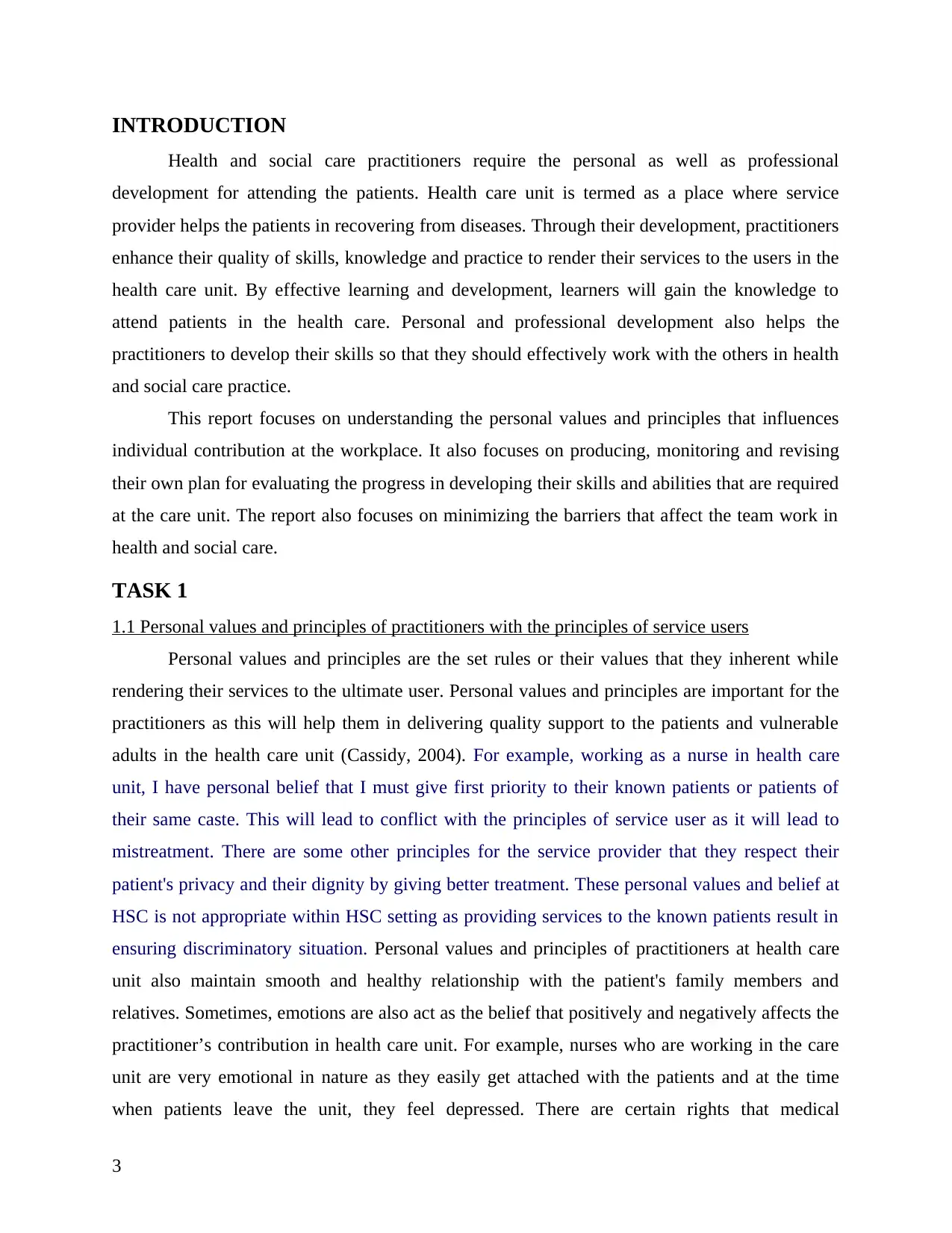
INTRODUCTION
Health and social care practitioners require the personal as well as professional
development for attending the patients. Health care unit is termed as a place where service
provider helps the patients in recovering from diseases. Through their development, practitioners
enhance their quality of skills, knowledge and practice to render their services to the users in the
health care unit. By effective learning and development, learners will gain the knowledge to
attend patients in the health care. Personal and professional development also helps the
practitioners to develop their skills so that they should effectively work with the others in health
and social care practice.
This report focuses on understanding the personal values and principles that influences
individual contribution at the workplace. It also focuses on producing, monitoring and revising
their own plan for evaluating the progress in developing their skills and abilities that are required
at the care unit. The report also focuses on minimizing the barriers that affect the team work in
health and social care.
TASK 1
1.1 Personal values and principles of practitioners with the principles of service users
Personal values and principles are the set rules or their values that they inherent while
rendering their services to the ultimate user. Personal values and principles are important for the
practitioners as this will help them in delivering quality support to the patients and vulnerable
adults in the health care unit (Cassidy, 2004). For example, working as a nurse in health care
unit, I have personal belief that I must give first priority to their known patients or patients of
their same caste. This will lead to conflict with the principles of service user as it will lead to
mistreatment. There are some other principles for the service provider that they respect their
patient's privacy and their dignity by giving better treatment. These personal values and belief at
HSC is not appropriate within HSC setting as providing services to the known patients result in
ensuring discriminatory situation. Personal values and principles of practitioners at health care
unit also maintain smooth and healthy relationship with the patient's family members and
relatives. Sometimes, emotions are also act as the belief that positively and negatively affects the
practitioner’s contribution in health care unit. For example, nurses who are working in the care
unit are very emotional in nature as they easily get attached with the patients and at the time
when patients leave the unit, they feel depressed. There are certain rights that medical
3
Health and social care practitioners require the personal as well as professional
development for attending the patients. Health care unit is termed as a place where service
provider helps the patients in recovering from diseases. Through their development, practitioners
enhance their quality of skills, knowledge and practice to render their services to the users in the
health care unit. By effective learning and development, learners will gain the knowledge to
attend patients in the health care. Personal and professional development also helps the
practitioners to develop their skills so that they should effectively work with the others in health
and social care practice.
This report focuses on understanding the personal values and principles that influences
individual contribution at the workplace. It also focuses on producing, monitoring and revising
their own plan for evaluating the progress in developing their skills and abilities that are required
at the care unit. The report also focuses on minimizing the barriers that affect the team work in
health and social care.
TASK 1
1.1 Personal values and principles of practitioners with the principles of service users
Personal values and principles are the set rules or their values that they inherent while
rendering their services to the ultimate user. Personal values and principles are important for the
practitioners as this will help them in delivering quality support to the patients and vulnerable
adults in the health care unit (Cassidy, 2004). For example, working as a nurse in health care
unit, I have personal belief that I must give first priority to their known patients or patients of
their same caste. This will lead to conflict with the principles of service user as it will lead to
mistreatment. There are some other principles for the service provider that they respect their
patient's privacy and their dignity by giving better treatment. These personal values and belief at
HSC is not appropriate within HSC setting as providing services to the known patients result in
ensuring discriminatory situation. Personal values and principles of practitioners at health care
unit also maintain smooth and healthy relationship with the patient's family members and
relatives. Sometimes, emotions are also act as the belief that positively and negatively affects the
practitioner’s contribution in health care unit. For example, nurses who are working in the care
unit are very emotional in nature as they easily get attached with the patients and at the time
when patients leave the unit, they feel depressed. There are certain rights that medical
3
⊘ This is a preview!⊘
Do you want full access?
Subscribe today to unlock all pages.

Trusted by 1+ million students worldwide
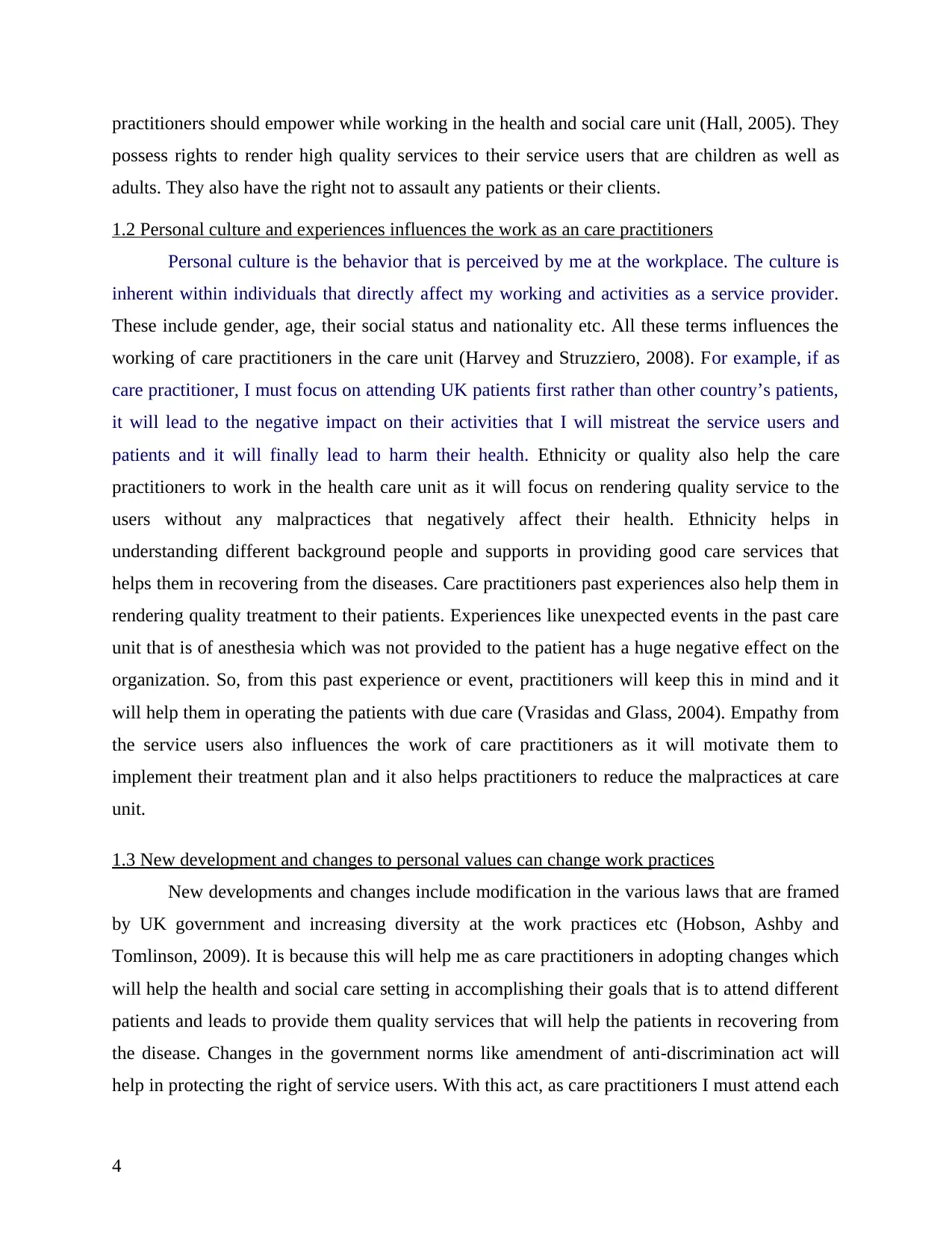
practitioners should empower while working in the health and social care unit (Hall, 2005). They
possess rights to render high quality services to their service users that are children as well as
adults. They also have the right not to assault any patients or their clients.
1.2 Personal culture and experiences influences the work as an care practitioners
Personal culture is the behavior that is perceived by me at the workplace. The culture is
inherent within individuals that directly affect my working and activities as a service provider.
These include gender, age, their social status and nationality etc. All these terms influences the
working of care practitioners in the care unit (Harvey and Struzziero, 2008). For example, if as
care practitioner, I must focus on attending UK patients first rather than other country’s patients,
it will lead to the negative impact on their activities that I will mistreat the service users and
patients and it will finally lead to harm their health. Ethnicity or quality also help the care
practitioners to work in the health care unit as it will focus on rendering quality service to the
users without any malpractices that negatively affect their health. Ethnicity helps in
understanding different background people and supports in providing good care services that
helps them in recovering from the diseases. Care practitioners past experiences also help them in
rendering quality treatment to their patients. Experiences like unexpected events in the past care
unit that is of anesthesia which was not provided to the patient has a huge negative effect on the
organization. So, from this past experience or event, practitioners will keep this in mind and it
will help them in operating the patients with due care (Vrasidas and Glass, 2004). Empathy from
the service users also influences the work of care practitioners as it will motivate them to
implement their treatment plan and it also helps practitioners to reduce the malpractices at care
unit.
1.3 New development and changes to personal values can change work practices
New developments and changes include modification in the various laws that are framed
by UK government and increasing diversity at the work practices etc (Hobson, Ashby and
Tomlinson, 2009). It is because this will help me as care practitioners in adopting changes which
will help the health and social care setting in accomplishing their goals that is to attend different
patients and leads to provide them quality services that will help the patients in recovering from
the disease. Changes in the government norms like amendment of anti-discrimination act will
help in protecting the right of service users. With this act, as care practitioners I must attend each
4
possess rights to render high quality services to their service users that are children as well as
adults. They also have the right not to assault any patients or their clients.
1.2 Personal culture and experiences influences the work as an care practitioners
Personal culture is the behavior that is perceived by me at the workplace. The culture is
inherent within individuals that directly affect my working and activities as a service provider.
These include gender, age, their social status and nationality etc. All these terms influences the
working of care practitioners in the care unit (Harvey and Struzziero, 2008). For example, if as
care practitioner, I must focus on attending UK patients first rather than other country’s patients,
it will lead to the negative impact on their activities that I will mistreat the service users and
patients and it will finally lead to harm their health. Ethnicity or quality also help the care
practitioners to work in the health care unit as it will focus on rendering quality service to the
users without any malpractices that negatively affect their health. Ethnicity helps in
understanding different background people and supports in providing good care services that
helps them in recovering from the diseases. Care practitioners past experiences also help them in
rendering quality treatment to their patients. Experiences like unexpected events in the past care
unit that is of anesthesia which was not provided to the patient has a huge negative effect on the
organization. So, from this past experience or event, practitioners will keep this in mind and it
will help them in operating the patients with due care (Vrasidas and Glass, 2004). Empathy from
the service users also influences the work of care practitioners as it will motivate them to
implement their treatment plan and it also helps practitioners to reduce the malpractices at care
unit.
1.3 New development and changes to personal values can change work practices
New developments and changes include modification in the various laws that are framed
by UK government and increasing diversity at the work practices etc (Hobson, Ashby and
Tomlinson, 2009). It is because this will help me as care practitioners in adopting changes which
will help the health and social care setting in accomplishing their goals that is to attend different
patients and leads to provide them quality services that will help the patients in recovering from
the disease. Changes in the government norms like amendment of anti-discrimination act will
help in protecting the right of service users. With this act, as care practitioners I must attend each
4
Paraphrase This Document
Need a fresh take? Get an instant paraphrase of this document with our AI Paraphraser
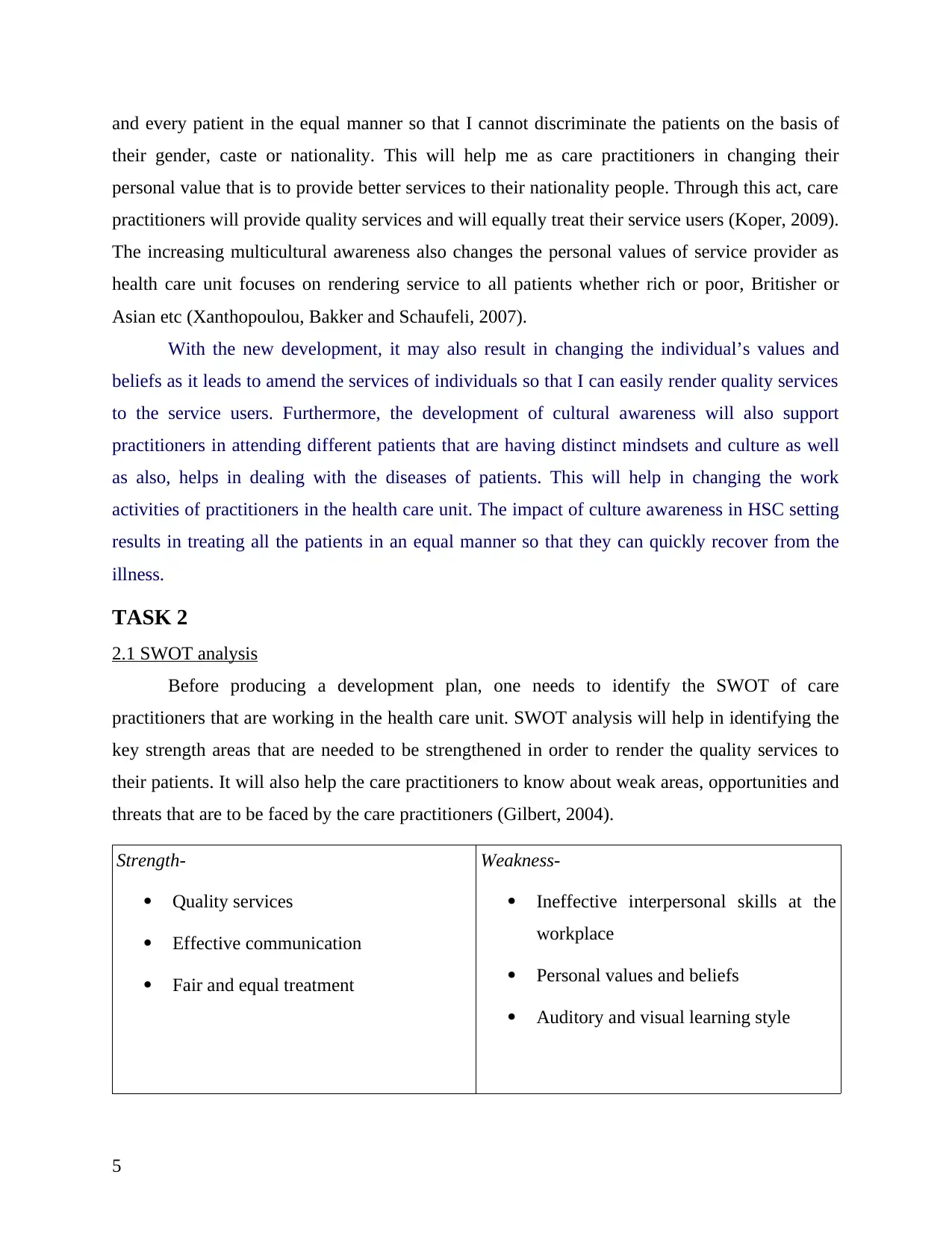
and every patient in the equal manner so that I cannot discriminate the patients on the basis of
their gender, caste or nationality. This will help me as care practitioners in changing their
personal value that is to provide better services to their nationality people. Through this act, care
practitioners will provide quality services and will equally treat their service users (Koper, 2009).
The increasing multicultural awareness also changes the personal values of service provider as
health care unit focuses on rendering service to all patients whether rich or poor, Britisher or
Asian etc (Xanthopoulou, Bakker and Schaufeli, 2007).
With the new development, it may also result in changing the individual’s values and
beliefs as it leads to amend the services of individuals so that I can easily render quality services
to the service users. Furthermore, the development of cultural awareness will also support
practitioners in attending different patients that are having distinct mindsets and culture as well
as also, helps in dealing with the diseases of patients. This will help in changing the work
activities of practitioners in the health care unit. The impact of culture awareness in HSC setting
results in treating all the patients in an equal manner so that they can quickly recover from the
illness.
TASK 2
2.1 SWOT analysis
Before producing a development plan, one needs to identify the SWOT of care
practitioners that are working in the health care unit. SWOT analysis will help in identifying the
key strength areas that are needed to be strengthened in order to render the quality services to
their patients. It will also help the care practitioners to know about weak areas, opportunities and
threats that are to be faced by the care practitioners (Gilbert, 2004).
Strength-
Quality services
Effective communication
Fair and equal treatment
Weakness-
Ineffective interpersonal skills at the
workplace
Personal values and beliefs
Auditory and visual learning style
5
their gender, caste or nationality. This will help me as care practitioners in changing their
personal value that is to provide better services to their nationality people. Through this act, care
practitioners will provide quality services and will equally treat their service users (Koper, 2009).
The increasing multicultural awareness also changes the personal values of service provider as
health care unit focuses on rendering service to all patients whether rich or poor, Britisher or
Asian etc (Xanthopoulou, Bakker and Schaufeli, 2007).
With the new development, it may also result in changing the individual’s values and
beliefs as it leads to amend the services of individuals so that I can easily render quality services
to the service users. Furthermore, the development of cultural awareness will also support
practitioners in attending different patients that are having distinct mindsets and culture as well
as also, helps in dealing with the diseases of patients. This will help in changing the work
activities of practitioners in the health care unit. The impact of culture awareness in HSC setting
results in treating all the patients in an equal manner so that they can quickly recover from the
illness.
TASK 2
2.1 SWOT analysis
Before producing a development plan, one needs to identify the SWOT of care
practitioners that are working in the health care unit. SWOT analysis will help in identifying the
key strength areas that are needed to be strengthened in order to render the quality services to
their patients. It will also help the care practitioners to know about weak areas, opportunities and
threats that are to be faced by the care practitioners (Gilbert, 2004).
Strength-
Quality services
Effective communication
Fair and equal treatment
Weakness-
Ineffective interpersonal skills at the
workplace
Personal values and beliefs
Auditory and visual learning style
5
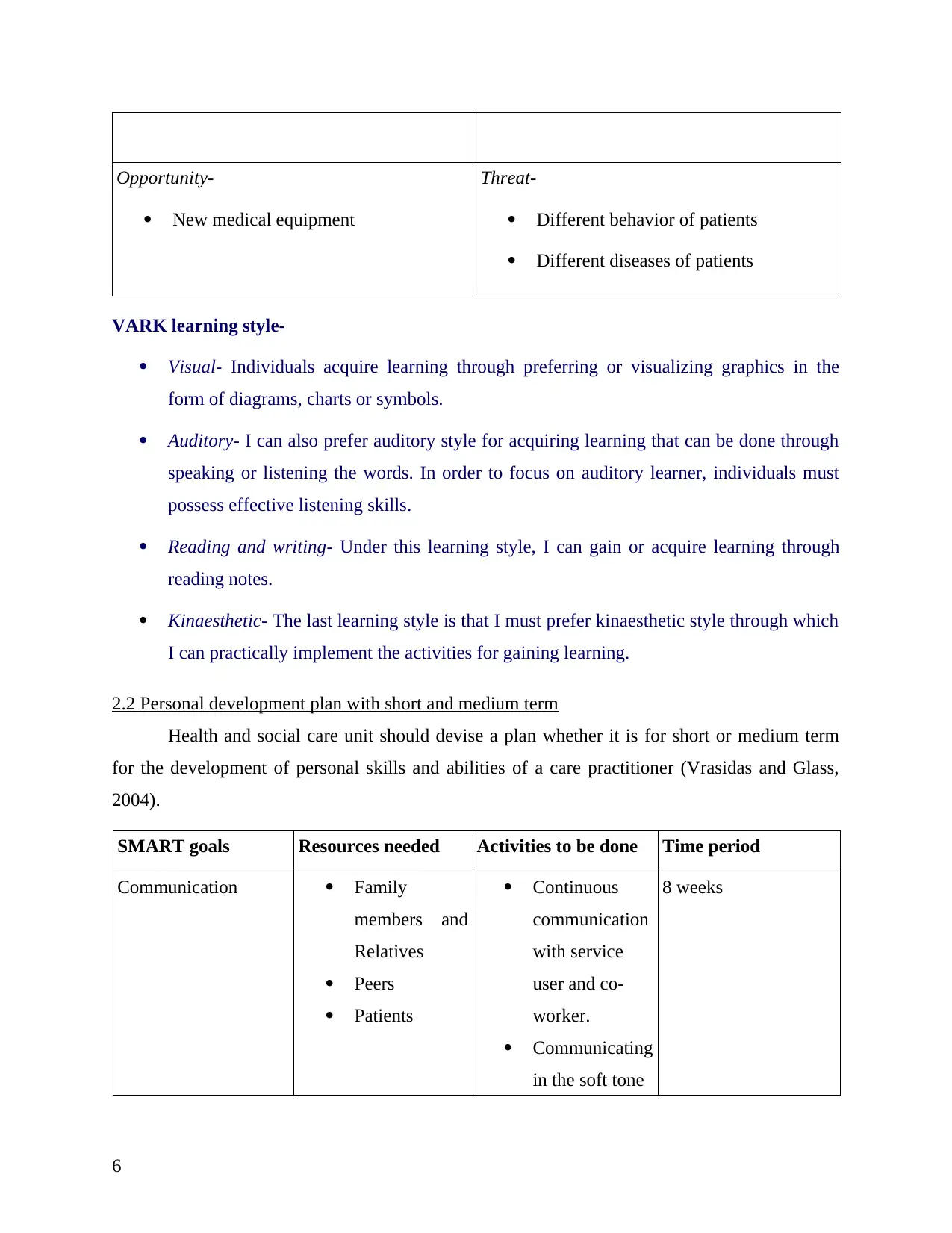
Opportunity-
New medical equipment
Threat-
Different behavior of patients
Different diseases of patients
VARK learning style-
Visual- Individuals acquire learning through preferring or visualizing graphics in the
form of diagrams, charts or symbols.
Auditory- I can also prefer auditory style for acquiring learning that can be done through
speaking or listening the words. In order to focus on auditory learner, individuals must
possess effective listening skills.
Reading and writing- Under this learning style, I can gain or acquire learning through
reading notes.
Kinaesthetic- The last learning style is that I must prefer kinaesthetic style through which
I can practically implement the activities for gaining learning.
2.2 Personal development plan with short and medium term
Health and social care unit should devise a plan whether it is for short or medium term
for the development of personal skills and abilities of a care practitioner (Vrasidas and Glass,
2004).
SMART goals Resources needed Activities to be done Time period
Communication Family
members and
Relatives
Peers
Patients
Continuous
communication
with service
user and co-
worker.
Communicating
in the soft tone
8 weeks
6
New medical equipment
Threat-
Different behavior of patients
Different diseases of patients
VARK learning style-
Visual- Individuals acquire learning through preferring or visualizing graphics in the
form of diagrams, charts or symbols.
Auditory- I can also prefer auditory style for acquiring learning that can be done through
speaking or listening the words. In order to focus on auditory learner, individuals must
possess effective listening skills.
Reading and writing- Under this learning style, I can gain or acquire learning through
reading notes.
Kinaesthetic- The last learning style is that I must prefer kinaesthetic style through which
I can practically implement the activities for gaining learning.
2.2 Personal development plan with short and medium term
Health and social care unit should devise a plan whether it is for short or medium term
for the development of personal skills and abilities of a care practitioner (Vrasidas and Glass,
2004).
SMART goals Resources needed Activities to be done Time period
Communication Family
members and
Relatives
Peers
Patients
Continuous
communication
with service
user and co-
worker.
Communicating
in the soft tone
8 weeks
6
⊘ This is a preview!⊘
Do you want full access?
Subscribe today to unlock all pages.

Trusted by 1+ million students worldwide
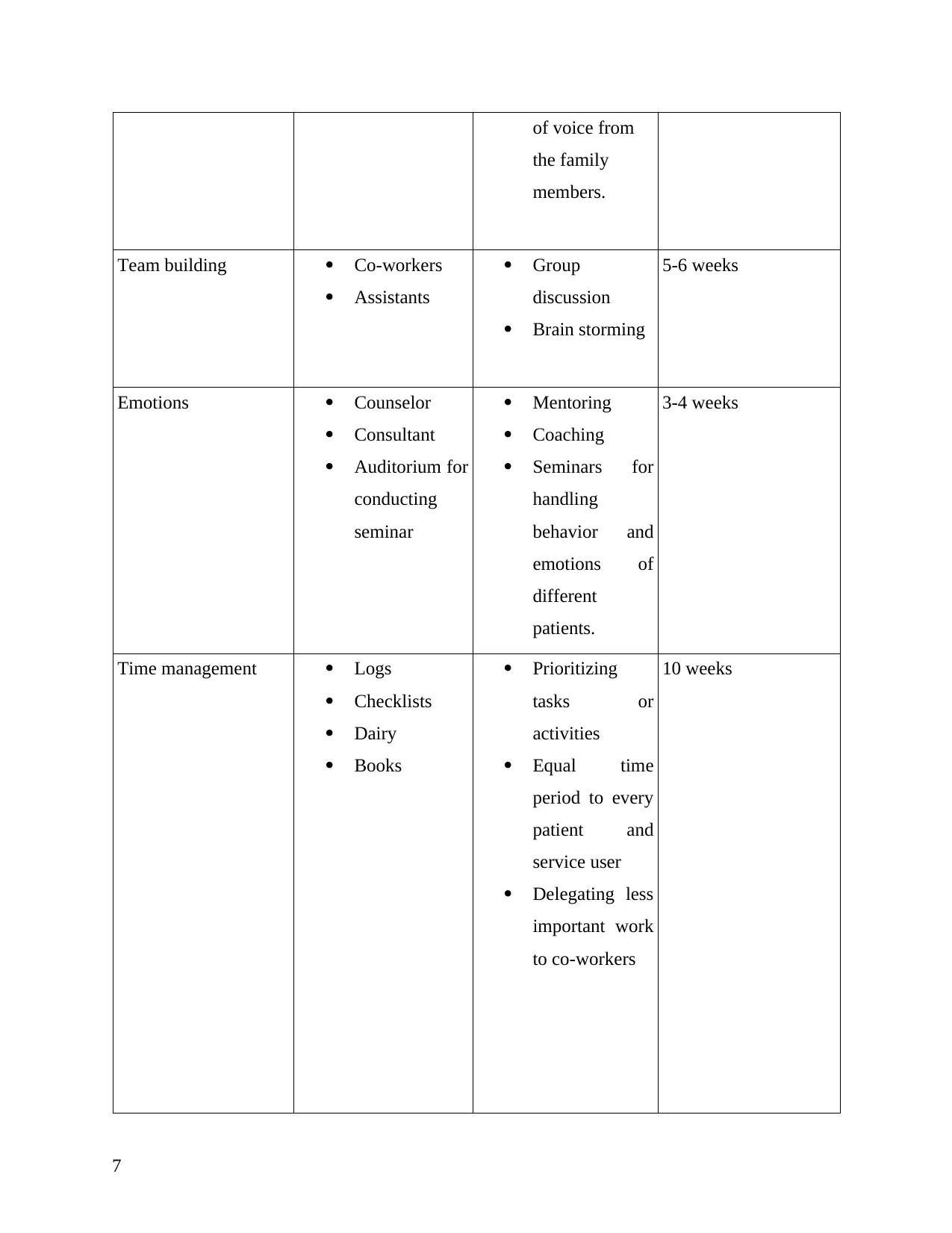
of voice from
the family
members.
Team building Co-workers
Assistants
Group
discussion
Brain storming
5-6 weeks
Emotions Counselor
Consultant
Auditorium for
conducting
seminar
Mentoring
Coaching
Seminars for
handling
behavior and
emotions of
different
patients.
3-4 weeks
Time management Logs
Checklists
Dairy
Books
Prioritizing
tasks or
activities
Equal time
period to every
patient and
service user
Delegating less
important work
to co-workers
10 weeks
7
the family
members.
Team building Co-workers
Assistants
Group
discussion
Brain storming
5-6 weeks
Emotions Counselor
Consultant
Auditorium for
conducting
seminar
Mentoring
Coaching
Seminars for
handling
behavior and
emotions of
different
patients.
3-4 weeks
Time management Logs
Checklists
Dairy
Books
Prioritizing
tasks or
activities
Equal time
period to every
patient and
service user
Delegating less
important work
to co-workers
10 weeks
7
Paraphrase This Document
Need a fresh take? Get an instant paraphrase of this document with our AI Paraphraser
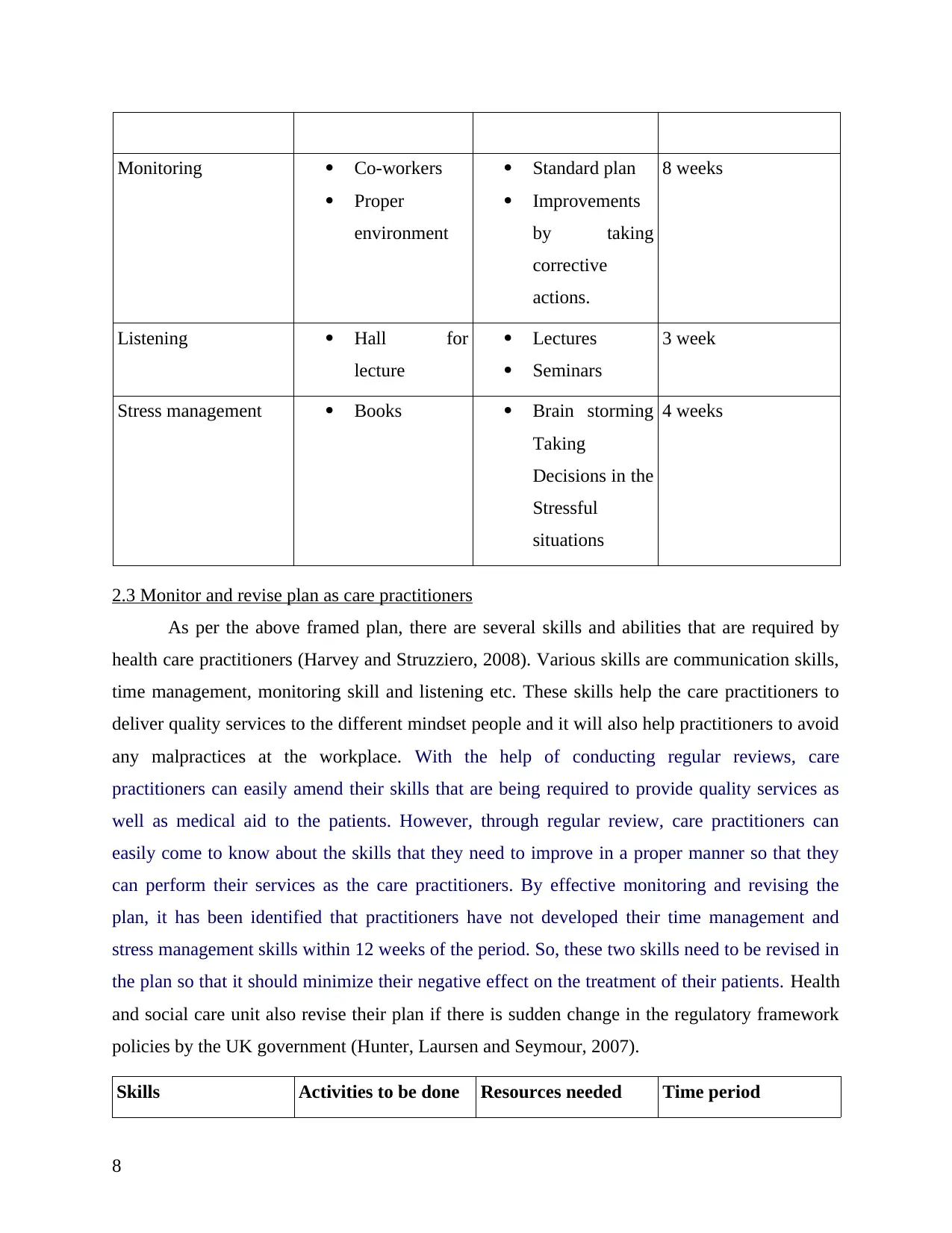
Monitoring Co-workers
Proper
environment
Standard plan
Improvements
by taking
corrective
actions.
8 weeks
Listening Hall for
lecture
Lectures
Seminars
3 week
Stress management Books Brain storming
Taking
Decisions in the
Stressful
situations
4 weeks
2.3 Monitor and revise plan as care practitioners
As per the above framed plan, there are several skills and abilities that are required by
health care practitioners (Harvey and Struzziero, 2008). Various skills are communication skills,
time management, monitoring skill and listening etc. These skills help the care practitioners to
deliver quality services to the different mindset people and it will also help practitioners to avoid
any malpractices at the workplace. With the help of conducting regular reviews, care
practitioners can easily amend their skills that are being required to provide quality services as
well as medical aid to the patients. However, through regular review, care practitioners can
easily come to know about the skills that they need to improve in a proper manner so that they
can perform their services as the care practitioners. By effective monitoring and revising the
plan, it has been identified that practitioners have not developed their time management and
stress management skills within 12 weeks of the period. So, these two skills need to be revised in
the plan so that it should minimize their negative effect on the treatment of their patients. Health
and social care unit also revise their plan if there is sudden change in the regulatory framework
policies by the UK government (Hunter, Laursen and Seymour, 2007).
Skills Activities to be done Resources needed Time period
8
Proper
environment
Standard plan
Improvements
by taking
corrective
actions.
8 weeks
Listening Hall for
lecture
Lectures
Seminars
3 week
Stress management Books Brain storming
Taking
Decisions in the
Stressful
situations
4 weeks
2.3 Monitor and revise plan as care practitioners
As per the above framed plan, there are several skills and abilities that are required by
health care practitioners (Harvey and Struzziero, 2008). Various skills are communication skills,
time management, monitoring skill and listening etc. These skills help the care practitioners to
deliver quality services to the different mindset people and it will also help practitioners to avoid
any malpractices at the workplace. With the help of conducting regular reviews, care
practitioners can easily amend their skills that are being required to provide quality services as
well as medical aid to the patients. However, through regular review, care practitioners can
easily come to know about the skills that they need to improve in a proper manner so that they
can perform their services as the care practitioners. By effective monitoring and revising the
plan, it has been identified that practitioners have not developed their time management and
stress management skills within 12 weeks of the period. So, these two skills need to be revised in
the plan so that it should minimize their negative effect on the treatment of their patients. Health
and social care unit also revise their plan if there is sudden change in the regulatory framework
policies by the UK government (Hunter, Laursen and Seymour, 2007).
Skills Activities to be done Resources needed Time period
8
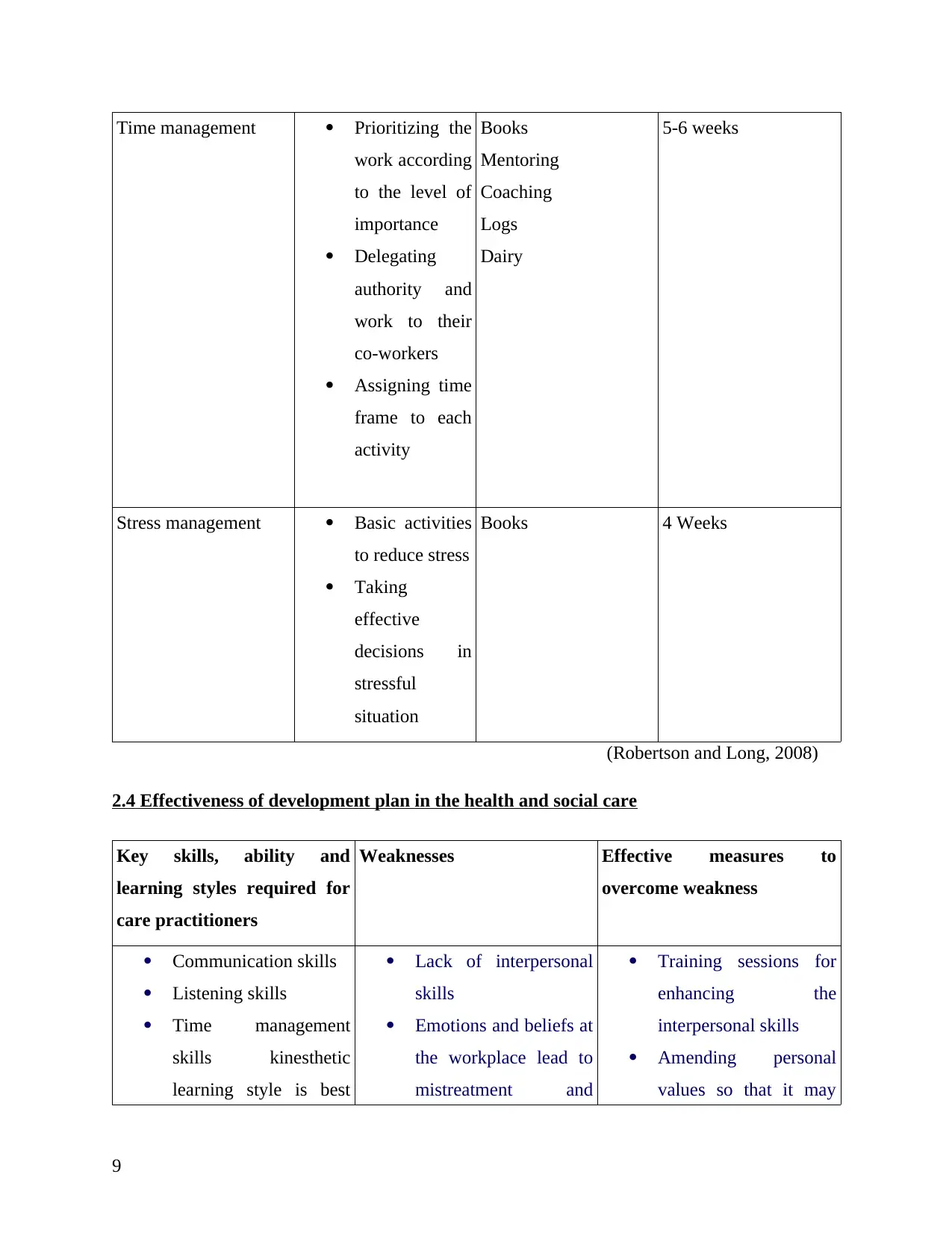
Time management Prioritizing the
work according
to the level of
importance
Delegating
authority and
work to their
co-workers
Assigning time
frame to each
activity
Books
Mentoring
Coaching
Logs
Dairy
5-6 weeks
Stress management Basic activities
to reduce stress
Taking
effective
decisions in
stressful
situation
Books 4 Weeks
(Robertson and Long, 2008)
2.4 Effectiveness of development plan in the health and social care
Key skills, ability and
learning styles required for
care practitioners
Weaknesses Effective measures to
overcome weakness
Communication skills
Listening skills
Time management
skills kinesthetic
learning style is best
Lack of interpersonal
skills
Emotions and beliefs at
the workplace lead to
mistreatment and
Training sessions for
enhancing the
interpersonal skills
Amending personal
values so that it may
9
work according
to the level of
importance
Delegating
authority and
work to their
co-workers
Assigning time
frame to each
activity
Books
Mentoring
Coaching
Logs
Dairy
5-6 weeks
Stress management Basic activities
to reduce stress
Taking
effective
decisions in
stressful
situation
Books 4 Weeks
(Robertson and Long, 2008)
2.4 Effectiveness of development plan in the health and social care
Key skills, ability and
learning styles required for
care practitioners
Weaknesses Effective measures to
overcome weakness
Communication skills
Listening skills
Time management
skills kinesthetic
learning style is best
Lack of interpersonal
skills
Emotions and beliefs at
the workplace lead to
mistreatment and
Training sessions for
enhancing the
interpersonal skills
Amending personal
values so that it may
9
⊘ This is a preview!⊘
Do you want full access?
Subscribe today to unlock all pages.

Trusted by 1+ million students worldwide
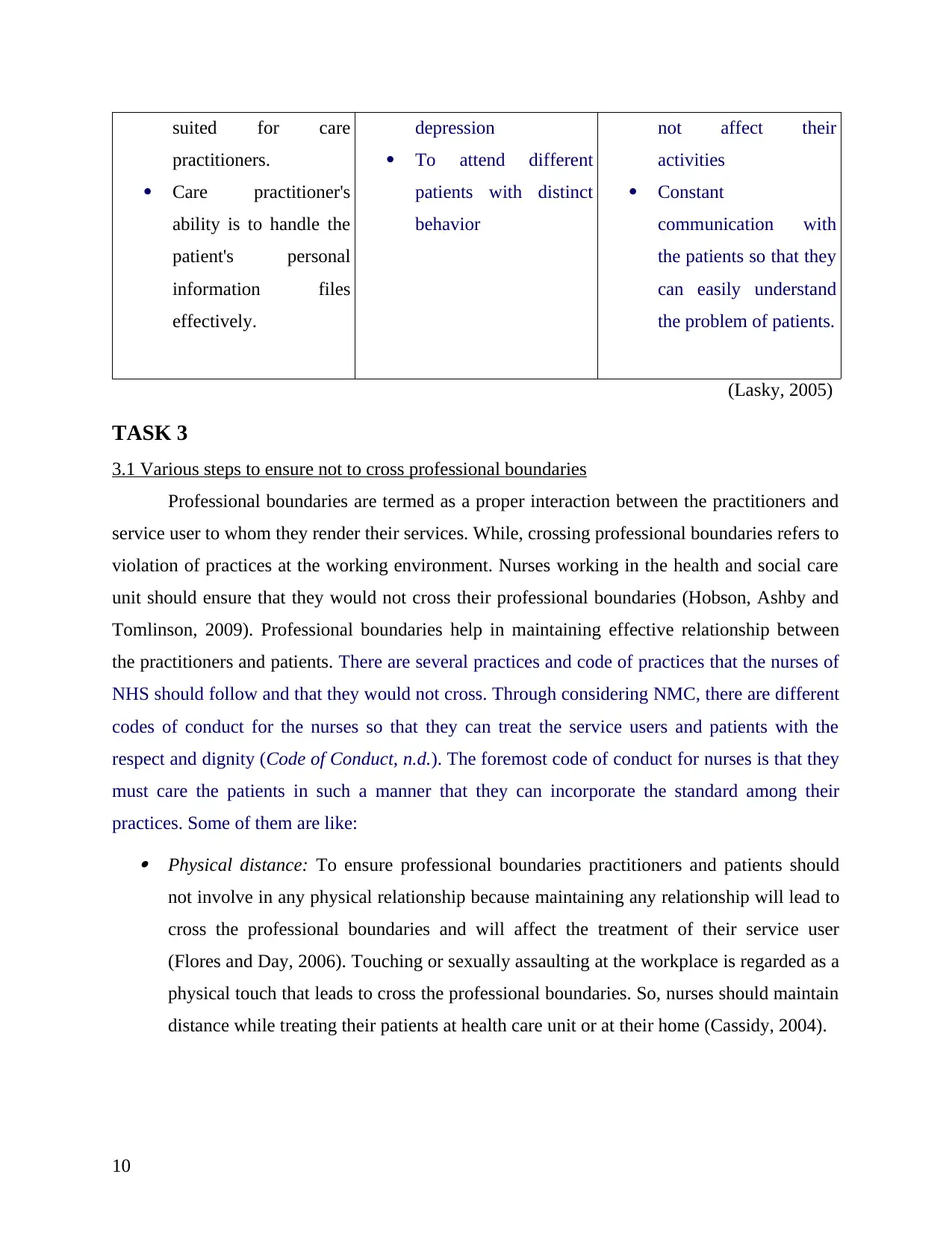
suited for care
practitioners.
Care practitioner's
ability is to handle the
patient's personal
information files
effectively.
depression
To attend different
patients with distinct
behavior
not affect their
activities
Constant
communication with
the patients so that they
can easily understand
the problem of patients.
(Lasky, 2005)
TASK 3
3.1 Various steps to ensure not to cross professional boundaries
Professional boundaries are termed as a proper interaction between the practitioners and
service user to whom they render their services. While, crossing professional boundaries refers to
violation of practices at the working environment. Nurses working in the health and social care
unit should ensure that they would not cross their professional boundaries (Hobson, Ashby and
Tomlinson, 2009). Professional boundaries help in maintaining effective relationship between
the practitioners and patients. There are several practices and code of practices that the nurses of
NHS should follow and that they would not cross. Through considering NMC, there are different
codes of conduct for the nurses so that they can treat the service users and patients with the
respect and dignity (Code of Conduct, n.d.). The foremost code of conduct for nurses is that they
must care the patients in such a manner that they can incorporate the standard among their
practices. Some of them are like: Physical distance: To ensure professional boundaries practitioners and patients should
not involve in any physical relationship because maintaining any relationship will lead to
cross the professional boundaries and will affect the treatment of their service user
(Flores and Day, 2006). Touching or sexually assaulting at the workplace is regarded as a
physical touch that leads to cross the professional boundaries. So, nurses should maintain
distance while treating their patients at health care unit or at their home (Cassidy, 2004).
10
practitioners.
Care practitioner's
ability is to handle the
patient's personal
information files
effectively.
depression
To attend different
patients with distinct
behavior
not affect their
activities
Constant
communication with
the patients so that they
can easily understand
the problem of patients.
(Lasky, 2005)
TASK 3
3.1 Various steps to ensure not to cross professional boundaries
Professional boundaries are termed as a proper interaction between the practitioners and
service user to whom they render their services. While, crossing professional boundaries refers to
violation of practices at the working environment. Nurses working in the health and social care
unit should ensure that they would not cross their professional boundaries (Hobson, Ashby and
Tomlinson, 2009). Professional boundaries help in maintaining effective relationship between
the practitioners and patients. There are several practices and code of practices that the nurses of
NHS should follow and that they would not cross. Through considering NMC, there are different
codes of conduct for the nurses so that they can treat the service users and patients with the
respect and dignity (Code of Conduct, n.d.). The foremost code of conduct for nurses is that they
must care the patients in such a manner that they can incorporate the standard among their
practices. Some of them are like: Physical distance: To ensure professional boundaries practitioners and patients should
not involve in any physical relationship because maintaining any relationship will lead to
cross the professional boundaries and will affect the treatment of their service user
(Flores and Day, 2006). Touching or sexually assaulting at the workplace is regarded as a
physical touch that leads to cross the professional boundaries. So, nurses should maintain
distance while treating their patients at health care unit or at their home (Cassidy, 2004).
10
Paraphrase This Document
Need a fresh take? Get an instant paraphrase of this document with our AI Paraphraser
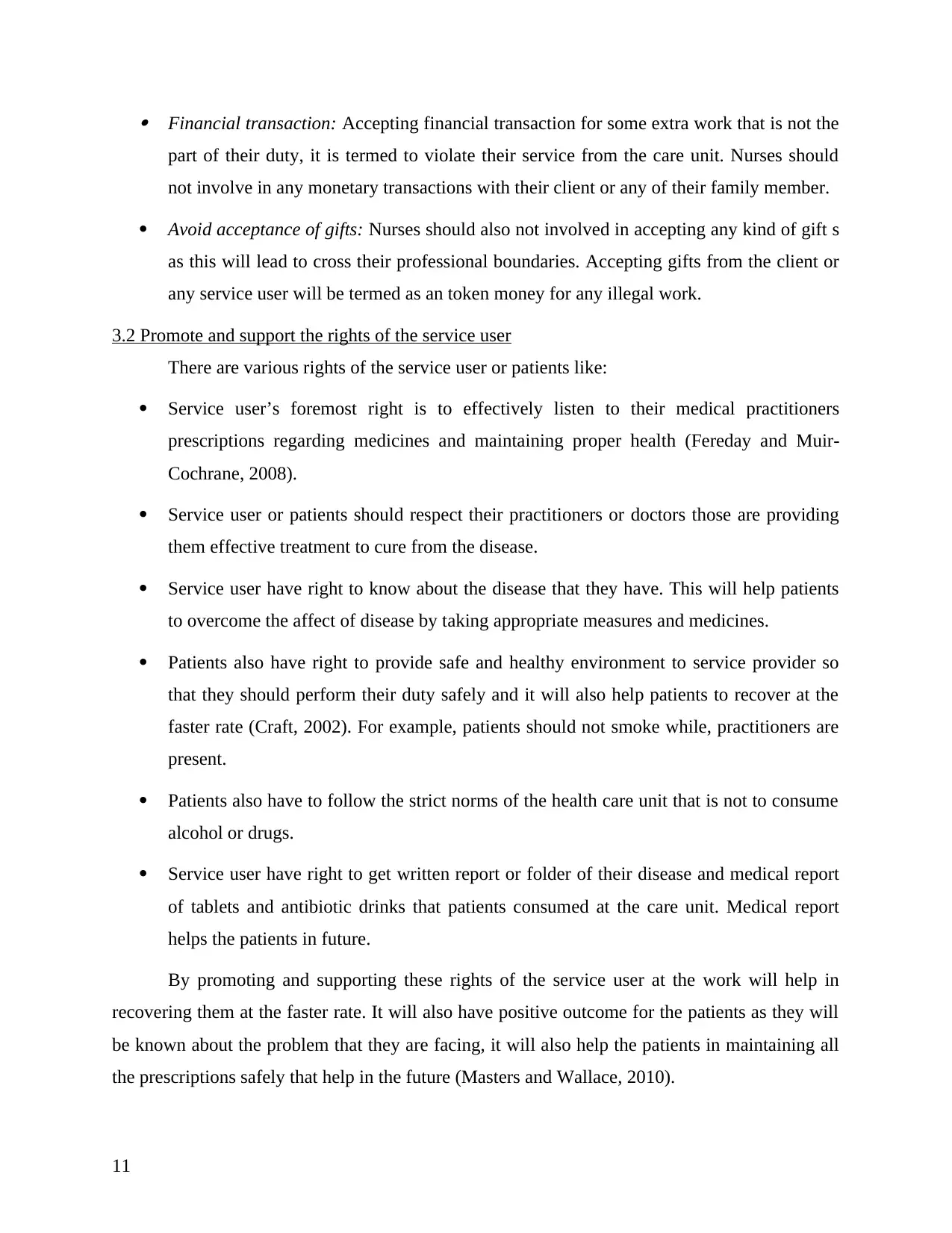
Financial transaction: Accepting financial transaction for some extra work that is not the
part of their duty, it is termed to violate their service from the care unit. Nurses should
not involve in any monetary transactions with their client or any of their family member.
Avoid acceptance of gifts: Nurses should also not involved in accepting any kind of gift s
as this will lead to cross their professional boundaries. Accepting gifts from the client or
any service user will be termed as an token money for any illegal work.
3.2 Promote and support the rights of the service user
There are various rights of the service user or patients like:
Service user’s foremost right is to effectively listen to their medical practitioners
prescriptions regarding medicines and maintaining proper health (Fereday and Muir-
Cochrane, 2008).
Service user or patients should respect their practitioners or doctors those are providing
them effective treatment to cure from the disease.
Service user have right to know about the disease that they have. This will help patients
to overcome the affect of disease by taking appropriate measures and medicines.
Patients also have right to provide safe and healthy environment to service provider so
that they should perform their duty safely and it will also help patients to recover at the
faster rate (Craft, 2002). For example, patients should not smoke while, practitioners are
present.
Patients also have to follow the strict norms of the health care unit that is not to consume
alcohol or drugs.
Service user have right to get written report or folder of their disease and medical report
of tablets and antibiotic drinks that patients consumed at the care unit. Medical report
helps the patients in future.
By promoting and supporting these rights of the service user at the work will help in
recovering them at the faster rate. It will also have positive outcome for the patients as they will
be known about the problem that they are facing, it will also help the patients in maintaining all
the prescriptions safely that help in the future (Masters and Wallace, 2010).
11
part of their duty, it is termed to violate their service from the care unit. Nurses should
not involve in any monetary transactions with their client or any of their family member.
Avoid acceptance of gifts: Nurses should also not involved in accepting any kind of gift s
as this will lead to cross their professional boundaries. Accepting gifts from the client or
any service user will be termed as an token money for any illegal work.
3.2 Promote and support the rights of the service user
There are various rights of the service user or patients like:
Service user’s foremost right is to effectively listen to their medical practitioners
prescriptions regarding medicines and maintaining proper health (Fereday and Muir-
Cochrane, 2008).
Service user or patients should respect their practitioners or doctors those are providing
them effective treatment to cure from the disease.
Service user have right to know about the disease that they have. This will help patients
to overcome the affect of disease by taking appropriate measures and medicines.
Patients also have right to provide safe and healthy environment to service provider so
that they should perform their duty safely and it will also help patients to recover at the
faster rate (Craft, 2002). For example, patients should not smoke while, practitioners are
present.
Patients also have to follow the strict norms of the health care unit that is not to consume
alcohol or drugs.
Service user have right to get written report or folder of their disease and medical report
of tablets and antibiotic drinks that patients consumed at the care unit. Medical report
helps the patients in future.
By promoting and supporting these rights of the service user at the work will help in
recovering them at the faster rate. It will also have positive outcome for the patients as they will
be known about the problem that they are facing, it will also help the patients in maintaining all
the prescriptions safely that help in the future (Masters and Wallace, 2010).
11
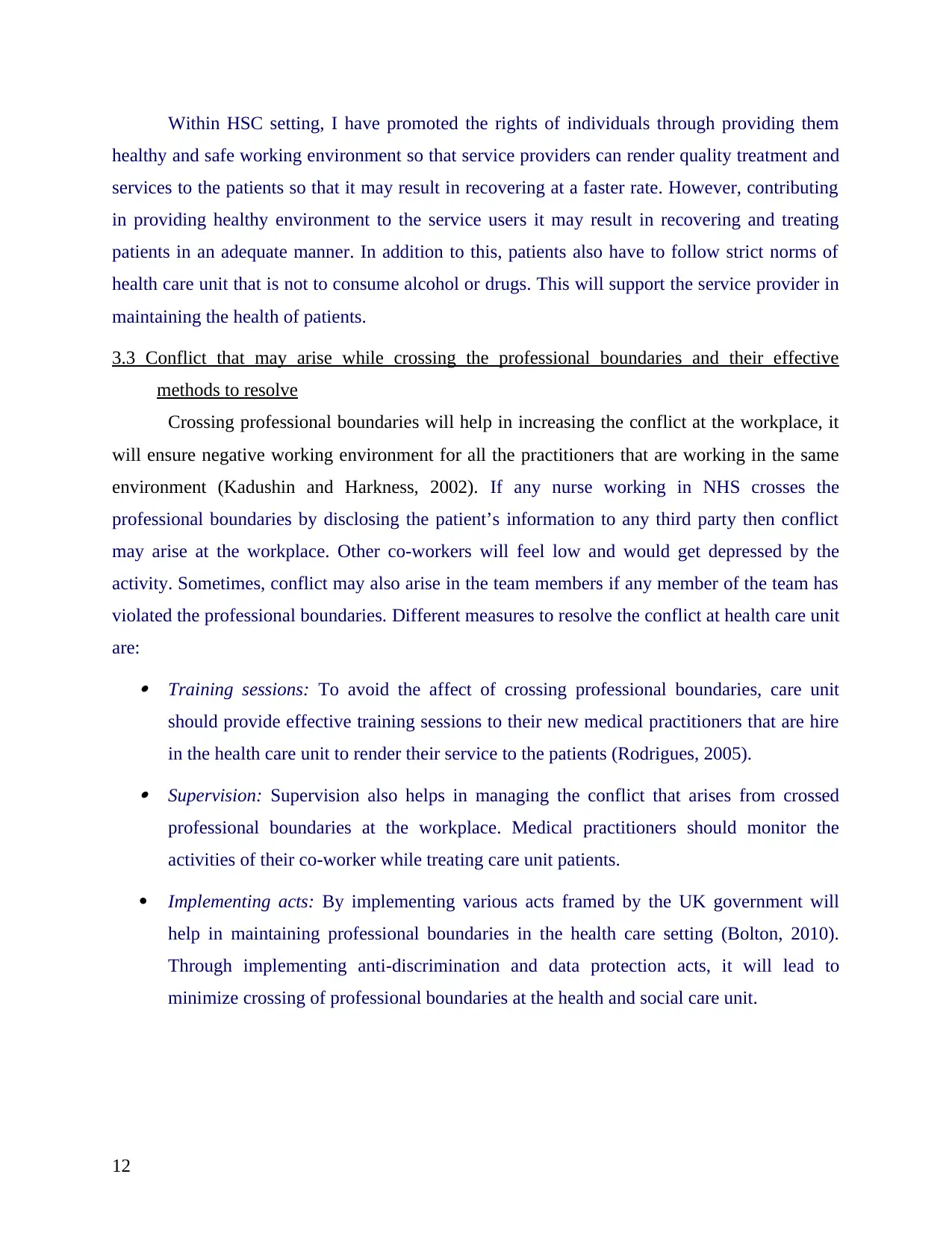
Within HSC setting, I have promoted the rights of individuals through providing them
healthy and safe working environment so that service providers can render quality treatment and
services to the patients so that it may result in recovering at a faster rate. However, contributing
in providing healthy environment to the service users it may result in recovering and treating
patients in an adequate manner. In addition to this, patients also have to follow strict norms of
health care unit that is not to consume alcohol or drugs. This will support the service provider in
maintaining the health of patients.
3.3 Conflict that may arise while crossing the professional boundaries and their effective
methods to resolve
Crossing professional boundaries will help in increasing the conflict at the workplace, it
will ensure negative working environment for all the practitioners that are working in the same
environment (Kadushin and Harkness, 2002). If any nurse working in NHS crosses the
professional boundaries by disclosing the patient’s information to any third party then conflict
may arise at the workplace. Other co-workers will feel low and would get depressed by the
activity. Sometimes, conflict may also arise in the team members if any member of the team has
violated the professional boundaries. Different measures to resolve the conflict at health care unit
are: Training sessions: To avoid the affect of crossing professional boundaries, care unit
should provide effective training sessions to their new medical practitioners that are hire
in the health care unit to render their service to the patients (Rodrigues, 2005). Supervision: Supervision also helps in managing the conflict that arises from crossed
professional boundaries at the workplace. Medical practitioners should monitor the
activities of their co-worker while treating care unit patients.
Implementing acts: By implementing various acts framed by the UK government will
help in maintaining professional boundaries in the health care setting (Bolton, 2010).
Through implementing anti-discrimination and data protection acts, it will lead to
minimize crossing of professional boundaries at the health and social care unit.
12
healthy and safe working environment so that service providers can render quality treatment and
services to the patients so that it may result in recovering at a faster rate. However, contributing
in providing healthy environment to the service users it may result in recovering and treating
patients in an adequate manner. In addition to this, patients also have to follow strict norms of
health care unit that is not to consume alcohol or drugs. This will support the service provider in
maintaining the health of patients.
3.3 Conflict that may arise while crossing the professional boundaries and their effective
methods to resolve
Crossing professional boundaries will help in increasing the conflict at the workplace, it
will ensure negative working environment for all the practitioners that are working in the same
environment (Kadushin and Harkness, 2002). If any nurse working in NHS crosses the
professional boundaries by disclosing the patient’s information to any third party then conflict
may arise at the workplace. Other co-workers will feel low and would get depressed by the
activity. Sometimes, conflict may also arise in the team members if any member of the team has
violated the professional boundaries. Different measures to resolve the conflict at health care unit
are: Training sessions: To avoid the affect of crossing professional boundaries, care unit
should provide effective training sessions to their new medical practitioners that are hire
in the health care unit to render their service to the patients (Rodrigues, 2005). Supervision: Supervision also helps in managing the conflict that arises from crossed
professional boundaries at the workplace. Medical practitioners should monitor the
activities of their co-worker while treating care unit patients.
Implementing acts: By implementing various acts framed by the UK government will
help in maintaining professional boundaries in the health care setting (Bolton, 2010).
Through implementing anti-discrimination and data protection acts, it will lead to
minimize crossing of professional boundaries at the health and social care unit.
12
⊘ This is a preview!⊘
Do you want full access?
Subscribe today to unlock all pages.

Trusted by 1+ million students worldwide
1 out of 16
Related Documents
Your All-in-One AI-Powered Toolkit for Academic Success.
+13062052269
info@desklib.com
Available 24*7 on WhatsApp / Email
![[object Object]](/_next/static/media/star-bottom.7253800d.svg)
Unlock your academic potential
Copyright © 2020–2025 A2Z Services. All Rights Reserved. Developed and managed by ZUCOL.





